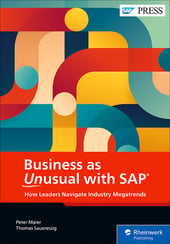Recently I had the opportunity to be interviewed about my book Business as Unusual with SAP: How Leaders Navigate Industry Megatrends and answer reader questions about the business trends that we at SAP have been uncovering.
In this post, I wanted to take the time to answer five additional questions that I wasn’t able to get to answering live, but wanted to for those who asked. You can also check out the replay of the Q&A below.
Q: Can you give us an example of solutions that enable companies to adapt to a megatrend?
A: Each megatrend chapter in the book closes with a set of solutions that are relevant to adapt to the respective megatrend. Here’s an example: If you want to sell a product “as a service” you need to be able to invoice accordingly, and “SAP Billing and Revenue Innovation Management enables scalable billing of simple to complex pricing structures based on metering” (page 67). So the book gives you concrete pointers about which SAP solutions are relevant to address a trend.
Q: What was the process like of incorporating the perspectives of so many customers and experts in your book?
A: Thomas Saueressig, my co-author, and I know a wide range of customers and industry experts who are leading the charge in navigating the megatrends, so it has been a matter of reaching out to them, explaining the project, and scheduling a conversation to discuss the megatrend and their strategies to deal with it. The content in the book are condensed excerpts of those interviews, and the experts of course had the opportunity to review and approve the final version.
Q: What are the timelines for SAP customers to embrace these megatrends and transform their businesses? Are these next practices 10 years from now? Or 5 years? Or 2 years?
A: We are practical people, so we focused on megatrends that are being tackled by industry leaders today and that are relevant for a wide range of enterprises. But we also looked at megatrends that will fully hit the industry a handful of years down the road—for example “personalized medicine at scale” is a few years from becoming mainstream. So we looked at evolving “next practices” and at leading practices that are ready to go mainstream today.
Q: Have some of these megatrends been shaped by the Covid-19 pandemic, and how do you see the change if so?
A: Most megatrends have been indirectly shaped by the pandemic, but supply networks and customer engagement have been very directly hit and transformed by the pandemic. Leaders have used the pandemic as a huge business innovation environment: how to engage with customers in new ways; how to deliver products and services in innovative, digital ways; and how to make supply networks more resilient. Those companies have used the opportunity to develop and validate “next practices” in a setting that allowed them to suspend traditions and many rules, and we see that many innovative business practices are here to stay.
Q: In the past, organizations have typically included market, tech, and industry trends in their strategic planning. Do you think this has become more challenging for organizations to plan for based on the rate and complexity of change? Also, what key challenges do you hear from customers in embracing some of these trends?
A: If General Moltke had been a business leader he might have said “no strategic plan survives contact with business reality,” and this is very true in a business environment that is repeatedly disrupted by pandemics, war, financial crises, or technology breakthroughs. Leading customers respond by designing their transformation programs to deliver tangible business value very rapidly. Multi-year projects with a single big bang at the end are pretty much a thing of the past. This means that an 80% cloud solution today is more useful than a 100% tailored solution three years down the road, knowing that the world will be different then. This needs significant new approaches to the engagement between business and IT, like deploying more experimental solutions in quick sprints or adapting business practices to available solutions. But business owners today are technology savvy, and IT people are fluent in business language, so there is a new level of synergies between business and technology.
This post was originally published 3/2023.




Comments